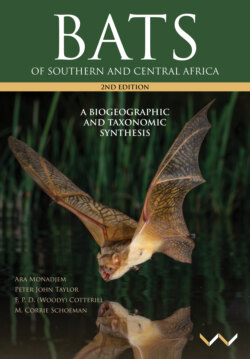Читать книгу Bats of Southern and Central Africa - Ara Monadjem - Страница 5
На сайте Литреса книга снята с продажи.
FOREWORD TO THE FIRST EDITION
ОглавлениеField and laboratory research on bats over the past decades has revealed numerous aspects about these nocturnal and generally secretive animals that include some rather extraordinary details. This new information, combined with public education, helps to dispel some of the incorrect notions about bats found within different cultural folklores and cinema myths. Ongoing research and new works on regional bat faunas further advance knowledge on these fascinating creatures and their conservation. A few of the many possible examples are presented here.
In certain portions of the world where fruit bats have been locally extirpated – generally associated with human hunting pressures – a reduction can be measured in the ability of forests to redevelop naturally after some form of disturbance, such as cyclones or forest clearing. These animals play a major role in the dissemination of forest tree seeds and habitat regeneration and restoration. Detailed analyses of the faeces of insectivorous bats have revealed that some species consume a large number of mosquitoes and flies, the most important vectors in the transmission of different diseases that afflict humans, such as malaria and dengue. Certain bats can consume up to 500 insects per night and, hence, a colony of 1,000 individuals devours 500,000 insects per night or approaching 200 million per year! In 2006, over 247 million people across the world were afflicted with malaria – a significant proportion on the African continent. The contribution bats make to reduce the number of insects that transmit diseases should not be underestimated, and aid in increasing the number of day roost sites, often a limiting factor in population size, through devices such as artificial bat boxes should be encouraged. Finally, research in the past few years has found that bats play an even greater role in ecosystem functioning than previously realised, reducing levels of herbivorous insects in both temperate and tropical areas, including agricultural settings. Hence, in short, bats are unsung heroes for the different ecological services they provide to our planet and humanity. Declining bat populations may compromise these benefits, and improved information on aspects of their distribution and natural history is critical for advancing their conservation.
Bats of Southern and Central Africa: A Biogeographic and Taxonomic Synthesis contains an extraordinary wealth of information on these animals. It is a synthesis of over a century of research in the southern portion of the continent. The authors, some of the foremost scientists in the study of African bats, have done an exceptional job in making this information available to natural historians, bat enthusiasts and scientists alike. There is vitality and precision to the text that clearly reflects their intimate knowledge of these animals in the field and their detailed studies of specimens in museums around the world. One aspect I found to be exceptional is that the research interests of the different authors are complementary, ranging from animal-specific and inventory field studies, classical and molecular systematics, to biogeography, echolocation, and conservation, further enhancing the contents and importance of this book. The introductory sections provide the needed background on geology and biotic systems in southern Africa to place aspects of bat distribution, ecology, and conservation into context, and the subsequent detailed species accounts provide considerable precise information.
The authors have found several commendable ways of bridging the needs of bat enthusiasts and scientists in the presentation of information. For example, I consider the utilisation of character matrices for identifying bats in the hand as an improvement on the classically used and often complicated system of dichotomous keys. In most cases, external characters are included in these matrices, allowing most species to be identified in the hand. Significantly, the authors are clear about the importance of voucher specimens for advancing knowledge. The range maps provide updated and precise information on the distribution of the different species, and at the same time details on modelling habitat preferences are also given without complicating the presentation. The spectrograms of echolocation calls are an extraordinary addition, which will help to advance studies and knowledge of bat vocalisations.
This is an important book for the region, as well as the world scientific literature, and will certainly be a critical reference for years to come. Knowledge and disseminated information on bats is a critical step in advancing conservation of these animals. The authors, with many decades of combined efforts in unravelling information and details on southern African bats, have produced a very useful book to meet this end and they should be praised for this effort.
Steven M. Goodman
Senior Field Biologist, Field Museum of Natural History (USA) and Conseil scientifique, Association Vahatra (Madagascar)
2010
